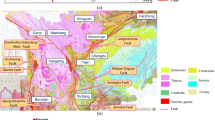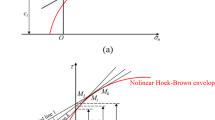Abstract
For tunnels excavated in soft layered rock strata, the secondary lining is susceptible to asymmetrical pressure and substantial concrete cracking. To solve this problem, a supporting system that combines a secondary lining with a highly deformable layer is proposed. First, field investigations were conducted to reveal the mechanical behaviors of the secondary lining of two typical tunnels situated in phyllite formation in China. Then, similarity model tests were used to analyze the mechanical responses of the secondary lining in layered rock stratum with different inclination angles. Finally, numerical simulation was adopted to systemically investigate the yielding mechanism of yielding layer in different cases. The results show that: (1) The distribution of inner force and deformation of lining is non-uniform due to the anisotropy of rock mass and geo-stress field, with the positive bending moment and larger axial force appearing mainly in the region where the tangent of the tunnel contour is parallel or vertical to the weak planes, respectively. (2) The existence of yielding layer has no influence on the distributed feature of inner force and displacement around tunnel perimeter, while it can significantly lower the magnitude of inner force and displacement of the lining. (3) The distinctly compressive zones of yielding layer coincide with the zones of positive bending moment, and the line connecting the central points of the evidently compressive zones on both sides will deflect towards the direction of minor principal stress to a certain extent. (4) The inner force and deformation of lining increase with the increase in the strength or decrease in the thickness of yielding layer, and this changing trend is related to the different supporting curves for linings with yielding layer of different strength and thickness.



















Similar content being viewed by others
References
Agharazi A (2013) Development of a 3D equivalent continuum model for deformation analysis of systematically jointed rock masses. Ph.D. Dissertation, University of Alberta
Anagnostou G, Cantieni L (2007) Design and analysis of yielding support in squeezing ground. In: Sousa LR, Olalla C, Grossmann N (eds), Proceedings of 11th Congress of the International Society for Rock Mechanics, Lisbon, Portugal, pp 829–832
Barla G, Bonin M, Semeraro M (2011) Analysis of the behaviour of a yield-control support system in squeezing rock. Tunn Undergr Space Technol 26:146–154
Bian K, Liu J, Xiao M, Liu ZP (2016) Cause investigation and verification of lining cracking of bifurcation tunnel at Huizhou Pumped Storage Power Station. Tunn Undergr Space Technol 54:123–134
Billig B, Ebsen B, Gipperich C, Schaab A, Wulff M (2007) DeCo-Grout - innovative grout to cope with rock deformations in TBM-tunnelling. In: Liu K (ed), Underground space-the 4th dimension of metropolises, ITA World Tunnel Congress, Prague, vol 2, Taylor & Francis Group, London, pp 1487–1492
Bonini M, Barla G (2012) The Saint Martin La Porte access adit (Lyon–Turin Base Tunnel) revisited. Tunn Undergr Space Technol 30:38–54
Bonini M, Lancellotta G, Barla G (2013) State of stress in tunnel lining in squeezing rock conditions. Rock Mech Rock Eng 46:405–411
Cantieni L, Anagnostou G (2009) The interaction between yielding supports and squeezing ground. Tunn Undergr Space Tech 24:309–322
Chen ZQ, He C, Xu GW, Ma GY, Yang WB (2019) Supporting mechanism and mechanical behavior of a double primary support method for tunnels in broken phyllite under high geo-stress: a case study. Bull Eng Geol Environ. https://doi.org/10.1007/s10064-019-01479-1
Chiu YC, Lee CH, Wang TT (2017) Lining crack evolution of an operational tunnel influenced by slope instability. Tunn Undergr Space Technol 65:167–178
Cho JW, Kim H, Jeon S, Min KB (2012) Deformation and strength anisotropy of Asan gneiss, Boryeong shale, and Yeoncheon schist. Int J Rock Mech Min Sci 50:158–169
Cui ZD, Liu DA, Wu FQ (2014) Influence of dip directions on the main deformation region of layered rock around tunnels. Bull Eng Geol Environ 73:441–450
David LN, Amorim DF, Sergio PB (2014) Simplified modeling of cracking in concrete: application in tunnel linings. Eng Struct 70:23–35
Duan K, Kwok CY (2015) Discrete element modeling of anisotropic rock under Brazilian test conditions. Int J Rock Mech Min Sci 78:46–56
Duan K, Kwok CY, Pierce M (2016) Discrete element method modeling of inherently anisotropic rocks under uniaxial compression loading. Int J Numer Anal Met 40:1150–1183
Fang Y, Guo JN, Grasmick J, Mooney M (2016) The effect of external water pressure on the liner behavior of large cross-section tunnels. Tunn Undergr Space Technol 65:167–178
Gao SM, Sun Y, Wang W, Chen JP (2017) Propagation of cracks in the secondary lining of tunnels subjected to asymmetrical pressure and a safety evaluation. Indian Geotech J 47:1–12
He C, Se J (2006) Maintenance and reinforcement of highway tunnel. China Communications Press, Peking (in Chinese)
Hoek E, Guevara R (2009) Overcoming squeezing in the Yacambu´-Quibor tunnel, Venezuela. Rock Mech Rock Eng 42:389–418
Huang HW, Liu DJ, Xue YD, Wang RP, Liu Y (2013) Numerical analysis of cracking of tunnel linings based on extended finite element. Chin J Geotech Eng 35:266–275 (in Chinese)
Labiouse V, Vietor T (2013) Laboratory and in situ simulation tests of the excavation damaged zone around galleries in Opalinus clay. Rock Mech Rock Eng 47:57–70
Lai JX, Qiu JL, Fan HB, Chen JX, Hu ZN, Zhang Q, Wang JB (2017) Structural safety assessment of existing multi-arch tunnel: a case study. Adv Mater Sci Eng Vol. 2017, Article ID 1697041, 11 pages
Lee DH, Keun H, Kim YG (2002) A study on mechanical behavior and cracking characteristic of tunnel lining by model experiment. Geosyst Eng 5:104–112
Lee CL, Shou KJ, Chen SS, Zhou WC (2019) Numerical analysis of tunneling in slates with anisotropic time-dependent behavior. Tunn Undergr Sp Tech 84:281–294
Lei MF, Peng LM, Shi CH (2015) Model test to investigate the failure mechanisms and lining stress characteristics of shallow buried tunnels under unsymmetrical loading. Tunn Undergr Space Technol 46:64–75
Lisjak A, Garitte B, Grasselli G, Muller HR, Vietor T (2015) The excavation of a circular tunnel in a bedded argillaceous rock (Opalinus Clay): Short-term rock mass response and FDEM numerical analysis. Tunn Undergr Sp Tech 45:227–248
Ma TF, Li SC, Xu XH, Zhang LC, Ping Y (2016) Model experimental study of deformation and failure law in excavation of deeprock mass with multi-cleftiness of different angles. Rock Soil Mech 37:2899–2908 (in Chinese)
Manh HT, Sulem J, Subrin D, Billaux D (2015a) Anisotropic time-dependent modeling of tunnel excavation in squeezing ground. Rock Mech Rock Eng 48:2301–2317
Manh HT, Sulem J, Subrin D (2015b) A closed-form solution for tunnels with arbitrary cross section excavated in elastic anisotropic ground. Rock Mech Rock Eng 48:277–288
Mezger F, Ramoni M, Anagnostou G (2018) Options for deformable segmental lining systems for tunnelling in squeezing rock. Tunn Undergr Space Tech 76:64–75
Oreste PP (2003) Analysis of structural interaction in tunnels using the covergence–confinement approach. Tunn Undergr Space Tech 18:347–363
Shi ZH, Ohtsu M, Suzuki M, Hibino Y (2001) Numerical analysis of multiple cracks in concrete using the discrete element approach. Struct Eng 127:1085–1091
Singh B, Goel RK, Jethwa JL, Dube AK (1997) Support pressure assessment in arched underground openings through poor rock masses. Eng Geol 48:59–81
Tonon F (2016) Sequential excavation, NATM and ADECO: what they have in common and how they differ. Tunn Undergr Space Technol 25:245–265
Vu TM, Sulem J, Subrin D, Monin N, Lascols J (2013) Anisotropic closure in squeezing rocks: the example of Saint-Martin-la-Porte access gallery. Rock Mech Rock Eng 46:231–246
Wang TT (2010) Characterizing crack patterns on tunnel linings associated with shear deformation induced by instability of neighboring slopes. Eng Geol 115:80–95
Xiao JZ, Dai FC, Wei YQ, Min H, Xu C, Tu XB, Wang ML (2014) Cracking mechanism of secondary lining for a shallow and asymmetrically-loaded tunnel in loose deposits. Tunn Undergr Space Technol 43:232–240
Xu GW (2017) Stability analysis of tunnels in layered phyllite stratum. Ph.D. Dissertation. Southwest Jiaotong University
Xu F, Li SC, Zhang QQ, Li LP, Shi SS, Zhang Q (2017) A new type support structure introduction and its contrast study with traditional support structure used in tunnel construction. Tunn Undergr Space Technol 63:171–182
Xu GW, He C, Chen ZQ, Wu D (2018) Effects of the micro-structure and micro-parameters on the mechanical behaviour of transversely isotropic rock in Brazilian tests. Acta Geotech 13:887–910
Yang JS, Fu JY (2015) Investigation and rehabilitation of lining imperfections and cracks in an operating railway tunnel. In: Shotcrete for Underground Support XII, ECI Symposium Series
Acknowledgements
This research was supported by the National key research and development program of China (Grant No. 2016YFC0802201). The insightful and constructive comments provided by the anonymous reviewer are greatly appreciated.
Author information
Authors and Affiliations
Corresponding author
Ethics declarations
Conflict of Interest
The authors declare that they have no conflicts of interest.
Additional information
Publisher's Note
Springer Nature remains neutral with regard to jurisdictional claims in published maps and institutional affiliations.
Appendix
Appendix
As it is difficult to quantify the support characteristic curve of yielding supporting system, we presented the schematic convergence–confinement curves in this article.
For rock bolts, its supporting stiffness, kbol, is (Oreste 2003):
where Est, L and φ are the elastic modulus, length and diameter of bolts; St and Sr are the circumferential spacing and longitudinal spacing; Q is the load–deformation constant for the anchor and head.
For shotcrete, its supporting stiffness, kshot, is (Oreste 2003):
where Eshot and νshot are the elastic modulus and Poisson’s ratio of shotcrete, respectively; R is the equivalent radius of the tunnel; tshot is the thickness of shotcrete.
For steel arch, its supporting stiffness, kst, is (Oreste 2003):
where Est, Ast, hst and d are the elastic modulus, area, height and spacing of steel arch.
For secondary lining, its supporting stiffness, ksec, is (Oreste 2003):
where Esec and νsec are the elastic modulus and Poisson’s ratio of secondary lining, respectively; R is the equivalent radius of the tunnel; tsec is the thickness of secondary lining.
For yielding layer, there is no explicit expression describing its supporting characteristic curve. Based on its stress–strain curve, the schematic image of its support characteristic curve is shown in Fig.
20a.
In each installation stage of supports, the stiffness of the system is simply given by the sum of the stiffness of each single element in the system.
Thus, for preliminary supports, the stiffness of the system is (Fig. 20b):
For secondary supports (secondary lining and yielding layer), the stiffness of the system is (Fig. 20c):
Stage AB: the yielding layer is in its elastic stage and the total stiffness:
Stage BC: the yielding layer is in its yielding stage and its stiffness changes to zero, and due to the yielding effect of yielding layer, the total stiffness is:
where α(u) is the effective ratio of secondary lining, and 0 < α(u) ≤ 1.
Point C: the yielding limit is reached, and the total stiffness is:
Stage CD: the yielding layer is in its plastic stage, and the total stiffness is:
Rights and permissions
About this article
Cite this article
Xu, G., He, C., Wang, J. et al. Study on the Mechanical Behavior of a Secondary Tunnel Lining with a Yielding Layer in Transversely Isotropic Rock Stratum. Rock Mech Rock Eng 53, 2957–2979 (2020). https://doi.org/10.1007/s00603-020-02107-1
Received:
Accepted:
Published:
Issue Date:
DOI: https://doi.org/10.1007/s00603-020-02107-1





